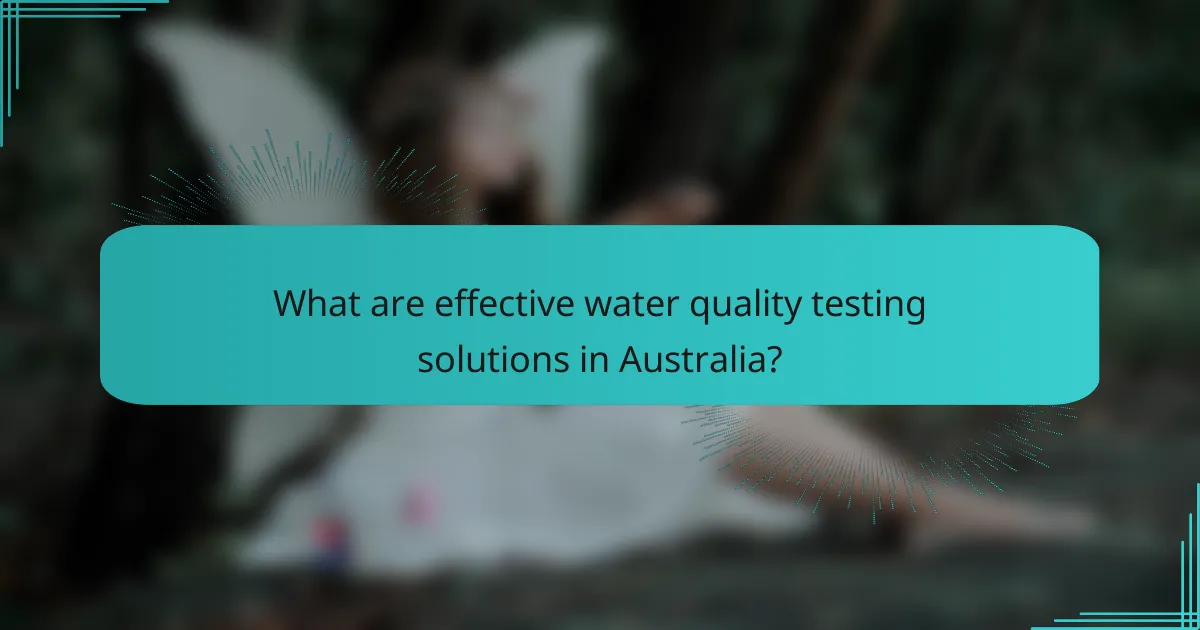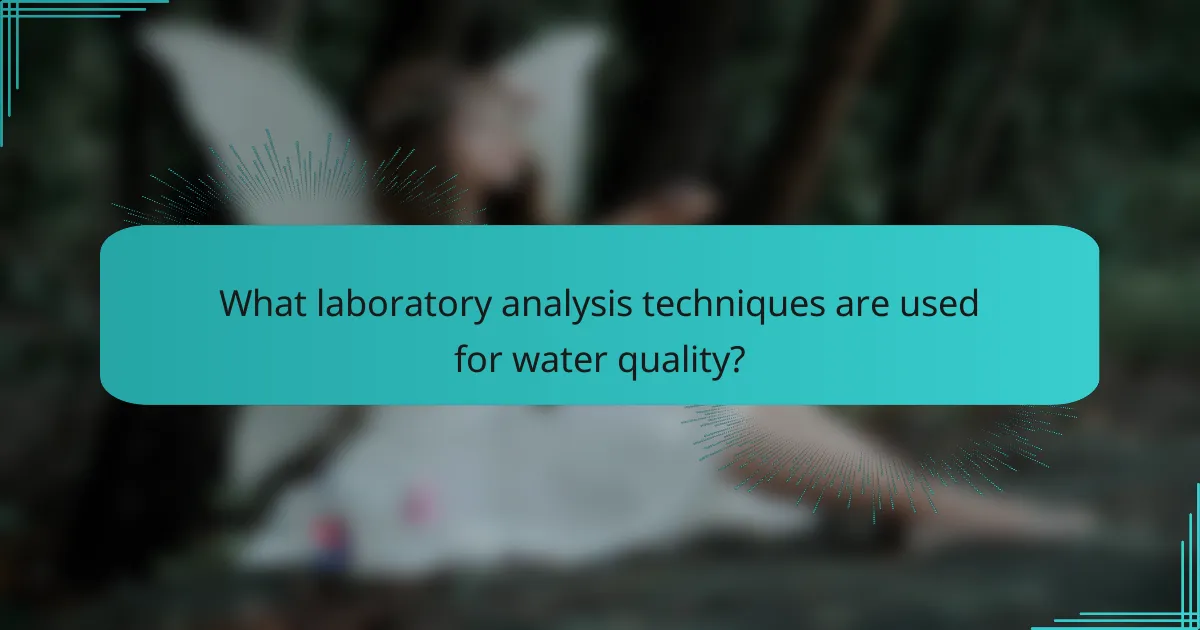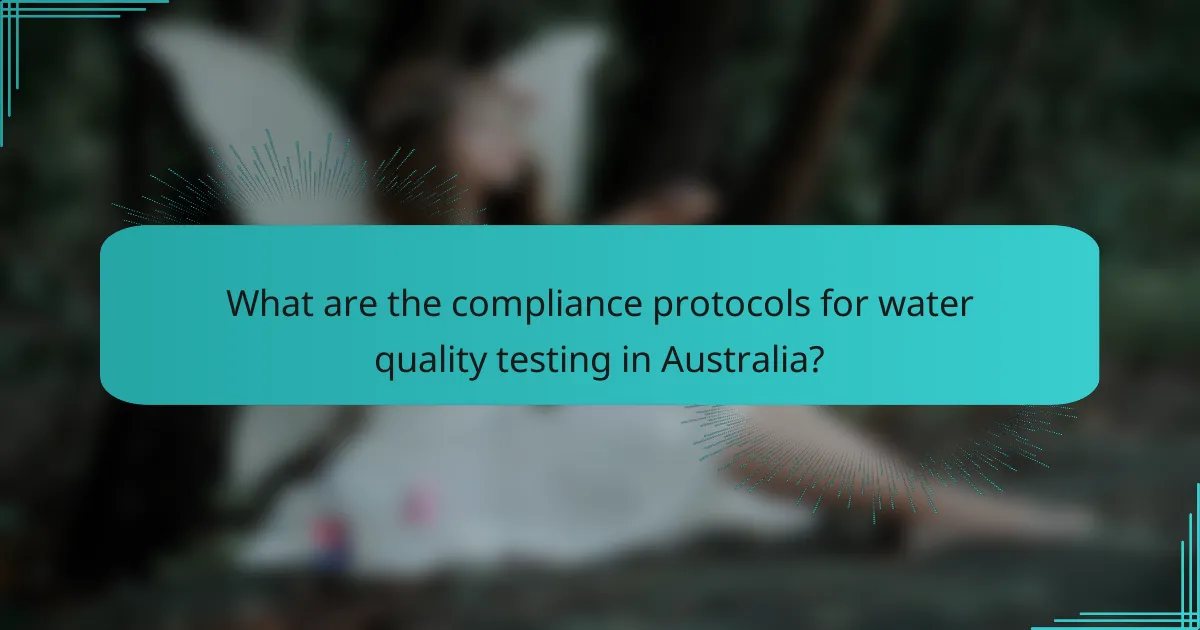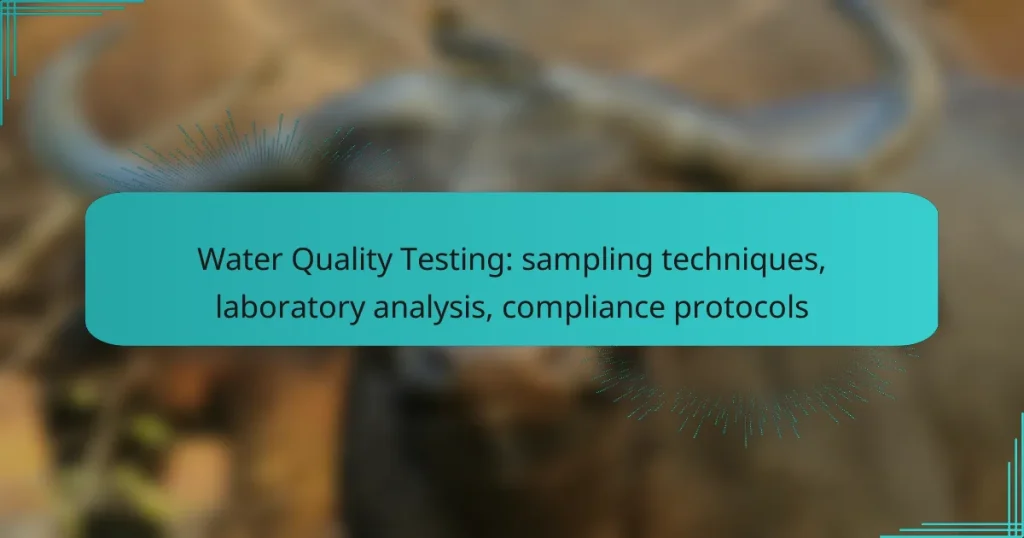Water quality testing is essential for safeguarding public health and the environment, involving a systematic approach that includes field sampling techniques, laboratory analysis, and adherence to compliance protocols. Selecting the right testing methods is critical and depends on the specific contaminants, testing conditions, and required accuracy. Implementing best practices in sample collection and preservation is vital to ensure reliable results and maintain the integrity of water quality throughout the testing process.

What are effective water quality testing solutions in Australia?
Effective water quality testing solutions in Australia involve a combination of field sampling techniques, laboratory analysis methods, and compliance with established standards. These solutions ensure that water sources meet safety and quality requirements for public health and environmental protection.
Field sampling techniques
Field sampling techniques are crucial for obtaining representative water samples. Common methods include grab sampling, where a single sample is taken at a specific time, and composite sampling, which involves collecting multiple samples over a period to average results. Each technique has its advantages; grab sampling is quick, while composite sampling provides a more comprehensive overview of water quality over time.
When conducting field sampling, it is essential to consider factors such as the sampling location, time of day, and weather conditions, as these can influence water quality. Properly sterilized containers and appropriate handling procedures must be followed to avoid contamination.
Laboratory analysis methods
Laboratory analysis methods for water quality testing typically include chemical, microbiological, and physical assessments. Common tests measure parameters such as pH, turbidity, dissolved oxygen, and the presence of contaminants like heavy metals or pathogens. Advanced techniques like gas chromatography and mass spectrometry may be employed for more detailed analyses.
Choosing the right laboratory method depends on the specific contaminants of concern and the required sensitivity of detection. Laboratories must adhere to strict protocols to ensure accuracy and reliability of results, often following guidelines set by the National Association of Testing Authorities (NATA) in Australia.
Compliance with Australian standards
Compliance with Australian standards is vital for ensuring water quality meets health and safety regulations. The Australian Drinking Water Guidelines provide a framework for assessing water quality, outlining acceptable limits for various contaminants. Regular testing and monitoring are necessary to maintain compliance and protect public health.
Water suppliers and testing laboratories must stay updated on changes to regulations and standards. Non-compliance can result in significant penalties and health risks, making adherence a top priority for all stakeholders involved in water quality management.
Water quality monitoring technologies
Water quality monitoring technologies have advanced significantly, offering real-time data collection and analysis. Sensors and automated sampling devices can continuously monitor parameters such as temperature, pH, and turbidity, providing immediate feedback on water quality changes. This technology is particularly useful in detecting contamination events quickly.
Implementing these technologies can enhance the efficiency of water quality management programs. However, it is essential to ensure that the equipment is properly calibrated and maintained to guarantee accurate readings. Regular training for personnel on using these technologies is also recommended to maximize their effectiveness.

How to choose the right water quality testing method?
Selecting the appropriate water quality testing method depends on the specific contaminants of concern, the testing environment, and the desired accuracy. Considerations include the sampling techniques, laboratory analysis capabilities, and compliance with local regulations.
Factors influencing method selection
Key factors that influence the selection of a water quality testing method include the type of water source (e.g., surface water, groundwater), the specific contaminants to be tested (e.g., bacteria, heavy metals), and the required sensitivity of the tests. For instance, testing for microbial contamination may require different methods compared to chemical analyses.
Additionally, the testing environment plays a crucial role. Field tests may be suitable for preliminary assessments, while laboratory analyses are often necessary for more accurate results. Understanding the limitations and capabilities of each method is essential for effective decision-making.
Cost considerations
Cost is a significant factor when choosing a water quality testing method. Field testing kits can range from low-cost options to more expensive, advanced equipment, while laboratory testing fees can vary widely based on the complexity of the analysis. Budgeting for both initial setup and ongoing testing expenses is important.
Consider the trade-off between cost and accuracy. While cheaper methods may save money upfront, they might not provide the detailed information needed for compliance or remediation efforts. Investing in reliable testing methods can ultimately save costs associated with incorrect assessments.
Regulatory compliance requirements
Compliance with local and national regulations is critical when selecting water quality testing methods. Standards set by organizations such as the Environmental Protection Agency (EPA) in the United States or equivalent bodies in other countries dictate acceptable testing protocols and methods for various contaminants.
Ensure that the chosen testing method aligns with these regulations to avoid penalties and ensure public safety. Regularly reviewing and updating testing protocols in accordance with regulatory changes can help maintain compliance and protect water resources effectively.

What are the best practices for water sampling?
Best practices for water sampling ensure accurate and reliable results. Proper techniques in sample collection, preservation, and transportation are crucial for maintaining water quality integrity throughout the testing process.
Sample collection procedures
Effective sample collection procedures involve selecting appropriate sampling points and using clean, sterilized containers. It’s essential to avoid contamination by rinsing the container with the water being sampled before filling it. For surface water, samples should be taken at mid-depth to capture representative quality.
When sampling groundwater, ensure that the well is purged before collecting the sample to remove stagnant water. Adhering to standard protocols, such as those outlined by the EPA, can help maintain consistency and reliability in results.
Preservation and transportation of samples
Preservation of water samples is vital to prevent changes in chemical composition. Samples should be cooled to around 4°C and, if necessary, acidified to maintain stability, especially for metals and nutrients. Use ice packs or refrigerated containers during transportation to the laboratory.
Ensure that samples are labeled clearly with date, time, and location of collection. Transport samples to the testing facility as quickly as possible, ideally within 24 hours, to minimize degradation and ensure accurate analysis.
Sampling frequency recommendations
Sampling frequency depends on the water source and the purpose of testing. For routine monitoring of drinking water, monthly sampling is often recommended, while surface water may require more frequent sampling during high rainfall or runoff events.
For compliance with regulations, check local guidelines, as some areas may have specific requirements for sampling frequency based on water quality concerns. Establishing a consistent schedule helps in identifying trends and potential issues over time.

What laboratory analysis techniques are used for water quality?
Laboratory analysis techniques for water quality encompass a variety of methods aimed at assessing physical, chemical, and biological parameters. These techniques help determine the safety and suitability of water for consumption and other uses.
Physical and chemical analysis
Physical and chemical analysis involves measuring parameters such as pH, turbidity, dissolved oxygen, and the presence of contaminants like heavy metals and nutrients. Common methods include spectrophotometry for chemical concentration and titration for acidity and alkalinity.
When conducting physical and chemical tests, ensure that samples are collected and stored properly to prevent changes in composition. For instance, samples for heavy metal analysis should be preserved with acid to prevent precipitation.
Microbiological testing methods
Microbiological testing methods assess the presence of pathogens, bacteria, and other microorganisms in water. Techniques include membrane filtration and multiple-tube fermentation, which help identify coliform bacteria and other indicators of contamination.
It is crucial to follow strict protocols during sample collection and analysis to avoid contamination. Samples should be processed quickly, ideally within 24 hours, to ensure accurate results.
Advanced analytical techniques
Advanced analytical techniques, such as gas chromatography and mass spectrometry, provide detailed insights into complex mixtures in water samples. These methods can detect trace levels of organic pollutants and emerging contaminants.
While these techniques offer high sensitivity and specificity, they often require specialized equipment and trained personnel. Consider the cost and time involved when deciding on the appropriate method for your water quality testing needs.

What are the compliance protocols for water quality testing in Australia?
Compliance protocols for water quality testing in Australia involve adhering to national guidelines and state-specific regulations to ensure safe water standards. These protocols dictate the methods of sampling, laboratory analysis, and reporting to maintain public health and environmental safety.
National water quality guidelines
The National Water Quality Management Strategy (NWQMS) provides a framework for water quality testing across Australia. It sets out guidelines that cover various aspects, including sampling techniques, analysis methods, and acceptable water quality standards. These guidelines aim to protect aquatic ecosystems and human health by establishing benchmarks for pollutants.
Water quality testing must align with the Australian Drinking Water Guidelines (ADWG), which specify the acceptable levels of contaminants in drinking water. Regular monitoring and compliance with these guidelines are essential for ensuring the safety of water supplies.
State-specific regulations
Each Australian state has its own regulations that complement the national guidelines, addressing local water quality issues. For example, New South Wales has the Water Management Act, which mandates specific testing protocols for surface and groundwater. These regulations often include unique requirements based on regional environmental conditions.
It is crucial for water testing organizations to familiarize themselves with these state-specific regulations to ensure compliance. Non-compliance can result in penalties and affect water supply licenses, making adherence a priority for water quality managers.
Reporting and documentation standards
Accurate reporting and thorough documentation are vital components of water quality testing compliance. Laboratories must maintain detailed records of sampling methods, analysis results, and any deviations from standard procedures. This documentation supports transparency and accountability in water quality management.
Reports should be submitted to relevant authorities within specified timeframes, often outlined in state regulations. Consistent and clear documentation helps in tracking water quality trends and facilitates timely responses to any identified issues.


